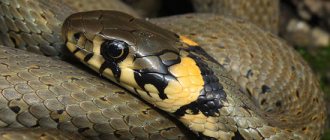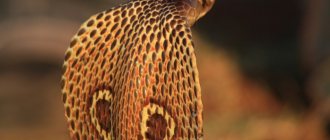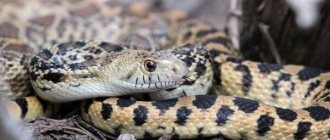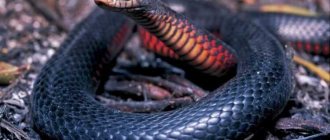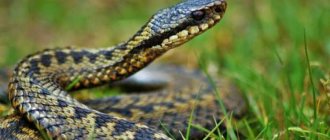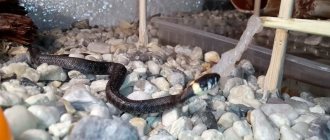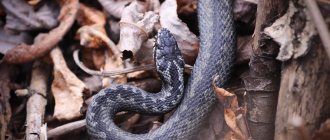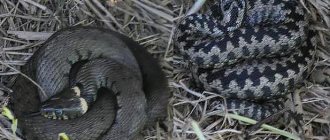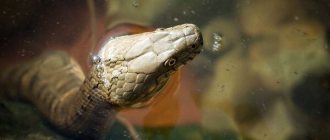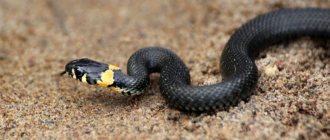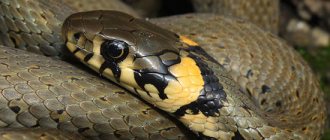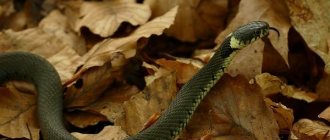- Wild animals
- >>
- Reptiles
The most common genus of non-venomous snakes is the snake , or as it is also called – the Real snake. Their Russian name comes from the Old Church Slavonic word “uzh”. It means rope. Representatives of the colubrid family actually vaguely resemble a small rope or cord in appearance. They live on almost the entire continent of Eurasia, where a temperate climate prevails.
Origin of the species and description
Snakes belong to the colubrid family. It is not known exactly when they appeared on the planet. However, given that the first species of snakes formed approximately 165 million years ago, it can be assumed that the distant ancestors of snakes began to disperse throughout the territories around the same time.
The snake can be easily distinguished from other snakes by the light spots behind the eyes
The snake has small dimensions compared to other species; only certain subtypes grow up to 3 meters, and the size of some does not exceed 15 cm. The snake is easily recognized by the yellow markings above the eyes, which most representatives have.
Females and males are practically indistinguishable from each other. The male can be recognized only by its elongated and thick tail. In females it is short and narrow. Interesting fact : the family of colubrids makes up 60% of all currently known species of snakes and is the most numerous.
The snake's body is covered with smooth scales that shimmer in the light. The scutes located on the belly are larger in size than those located near the ridge. The organ system of snakes has an interesting feature: the right lung is several times larger than the left, and the latter may be completely absent. However, the snake does not have any breathing problems. The animal has fairly mobile jaws due to the presence of connecting ligaments. This makes it possible to swallow prey that is larger than the mouth opening.
Snakes prefer to settle in humid climates, so if one of the individuals is encountered in nature, most likely there is a river or lake nearby. The animal moves well underwater and can survive without oxygen for a long time.
Snake Reproduction
After mating, the male’s functions end, and the female begins bearing offspring or forming a clutch. In the process of evolution, snakes have developed three methods of reproduction:
- live birth;
- eggs;
- cloning.
Viviparous method
Viviparous are vipers, boas, anacondas, and rattlesnakes. After fertilization, the female carries the embryos for several months (1-2 months, very rarely - 3). At this time, the cubs receive nutrition through metabolic processes with the mother’s body, as well as substances from the yolk sac. Such babies are immediately born ready to get their own food and defend themselves from enemies.
Ovoviviparity
Ovoviviparous snakes give birth to live young, but they are formed in eggs inside the mother's body. The cub feeds on the yolk of the egg. Among terrestrial reptiles, tiger snakes, copperheads, and boa constrictors reproduce in this way. Marine species of snakes reproduce in the same way. The baby is born and hatches from the egg at the same time. This same unique method is shared with snakes by some species of marine fish.
Did you know? Snake sex is the longest lasting. It can last up to 10 days without a break.
Traditional egg laying
70% of snakes are oviparous. These are taipans, cobras, mambas, grass snakes and other species. An important stage in raising offspring is the formation of a clutch. In warm countries with a tropical or subtropical climate, the female buries her eggs in a hole in the sand. Heating the sand by the sun guarantees the warming of the masonry. This is what the taipans do, for example. This is where the mother’s participation in raising her offspring ends. The clutches of tropical snakes can take a very long time to heat up and mature - up to 9 months.
In countries with insufficient soil heat, the female lays the eggs in a hole in the grass and warms them with her body. The snake's muscles contract regularly, producing the heat needed by the clutch. Heat is also generated due to the rotting of organic matter (leaves and grass).
Important! Oviparous species, including vipers, choose compost heaps for laying, that is, places that already have rotting grass, to provide the cubs with the necessary level of warmth. You need to be very careful when interacting with such piles and any accumulations of grass in areas where snakes live.
Appearance and features
As mentioned above, most snakes are small in size. The length of many individuals is only a couple of tens of centimeters. With rare exceptions, in some species individuals can grow to impressive sizes.
The average length of snakes is 1-1.2 m
Snakes have a slender body, and the head does not stand out much against its background. Its thickness is approximately the same as the body. The snake's head is covered with large scales that perform a protective function. In the neck area the scutes become significantly smaller and remain the same size right up to the tail. Snakes molt periodically, shedding their old skin in one piece. This happens when the snake crawls into a narrow space and clings to the surface with its scales.
The shape of the eyes depends on the species. An individual can have round, vertical and horizontal pupil shapes. The tail makes up approximately 1/5 of the total body length. In most cases it is cone-shaped, but can take on other contours.
The body of snakes has a wide variety of colors. Among the species, individuals with black, gray, brown, and olive skin are common. It is also common to see snakes that have several colors and different patterns on their scales. The belly of snakes is always light: yellow, white or gray.
The snake's mouth contains a forked tongue, as well as a set of small teeth. Moreover, the closer they are to the throat, the larger they are.
Range – where does it live?
Habitat of the common snake in Europe
In order for the snake to feel comfortable, it needs to live in areas with high moisture. That is why it settles near bodies of water. You can meet snakes in most European countries, with the exception of those places where there is a cold climate. Some species live in Africa, but try not to crawl into deserts and other hot areas.
Interesting fact : some species of snakes live underground. During the day they burrow into the soil and rest, and towards night they come out and go hunting.
Snakes are found in large numbers in the CIS countries, since the local climate is ideal for them. Moreover, individual individuals specially accustom themselves to a dry climate and hard soil and move to such territories. This may be due to the high population size and competition for territory and food. Snakes also live in Asia, Australia and some islands. For example, several species are found in the Philippines, where they feel quite comfortable. Most individuals are nocturnal, preferring not to appear in the sun again. Snakes love tall foliage because... it serves as an excellent camouflage. Thanks to it, the animal is able to hide from prying eyes and unexpectedly sneak up on prey during the hunt.
Interesting: Which venomous snake is the largest?
Lifestyle of a water snake
These snakes are active during daylight hours. At night, they take refuge under stones and other objects lying on the shore, in burrows of other animals, in various cracks and depressions under plants. They may hide in hay or dense vegetation. Large nocturnal concentrations of grass snakes are observed in reed thickets. On cool mornings they are slow and bask in sunlit areas. Having warmed up, they go into the water to hunt. Well-fed, they also often rest in the sun. But they don’t like intense heat - they hide from it in thickets or in water.
Water snakes spend the wintering period on the shore - in rodent burrows, voids in the soil - at a considerable depth (up to 80 cm). They usually spend the winter alone or in small groups, but mass concentrations of snakes have also been found - up to two hundred individuals of different sexes and ages. Such collective shelters are used by snakes from year to year.
Where and how do snakes winter?
Since snakes are cold-blooded creatures, they feel comfortable only in hot climates. Snakes become inactive and begin to prepare for hibernation in the fall, when the temperature begins to gradually decrease. Even before the onset of winter, they fall into suspended animation. So they survive the cold without moving and wait for the climate to become hot again.
Snakes are great at climbing trees
They come out of hibernation in the spring, and not in a specific month, but when the temperature becomes favorable for this. In fact, suspended animation in snakes lasts for a different period of time every year, which depends on the onset of frost and its end. The snake will not stop activity in advance, and will continue to lead its usual way of life until the end. The same applies to coming out of hibernation. As soon as it becomes warm enough, the individual will immediately come to life.
For wintering, snakes look for places where winter frosts will not reach. They are not afraid of low temperatures, but as a den, individuals choose a corner where the temperature during the cold weather will be as high as possible. Moreover, several individuals can be hibernating in one place at once.
Interesting fact : there have been cases when in winter people found snake dens for hibernation, inside which there were 40-60 snakes.
If other species of snakes live in the surrounding areas, they may join the snakes during hibernation. Since it is sometimes difficult to find places with suitable conditions, the animals cooperate and share one den for all.
When winter ends, cold-blooded creatures crawl out of their shelter to the surface. It takes them a couple of days to even out their body temperature and become active. Having basked enough in the sun, the snakes become mobile, return to their territories and begin hunting.
Maintenance of an ordinary house
Snakes tolerate captivity remarkably well, are easily tamed and undemanding in maintenance. They need a horizontal type terrarium (50*40*40 cm) with the following equipment:
- thermal cord/thermal mat for heating (+30+33 degrees in a warm corner);
- gravel, paper or coconut shavings for the substrate;
- shelter in a warm corner (to maintain humidity it is placed in a ditch with sphagnum moss);
- shelter in a cold corner (dry);
- a spacious container with water so that the snake can swim there, soak in water when molting, and not only quench its thirst;
- UV lamp for daylight.
On sunny days, additional illumination of the terrarium is not required . Once a day it is sprayed with warm water so that the sphagnum always remains moist. The snake's home diet consists of small fish and frogs: it is desirable that the prey show signs of life, otherwise the pet may refuse to eat.
This is interesting! Sometimes snakes are accustomed to defrosted foods. Colubrids are fed 1-2 times a week, large reptiles - even less often. Once a month, mineral supplements are mixed into the food, and mineral water is given instead of regular water. The water in the drinking bowl is changed daily.
If desired, the snake is hibernated, for which, with the onset of autumn, the lighting/heating time is reduced from 12 to 4 hours. After you reduce the temperature in the terrarium to +10+12 degrees and stop lighting it, the snake will go into hibernation (up to 2 months). The sleep you simulate will have a beneficial effect on the body of a rested pet.
Tags: amphibians, habitat, appearance, snakes, life expectancy, breeding at home, reproduction, reptiles
What does he eat?
Snakes are predators, with amphibians and small fish making up the majority of their diet. The cold-blooded fish swims well and has excellent reactions, which allows it to get food under water without any problems. Most of all, the snake prefers frogs and tadpoles. If they are rarely found in the area, they can switch to other creatures and even raid lizard lairs. In them the snake eats the eggs.
Interesting fact : when there is an acute shortage of food, adults do not mind having a snack with their younger relatives.
Already going hunting in a pond
If an individual has impressive dimensions, it is capable of eating larger animals. This is how rats, mice, moles, birds, squirrels and other creatures can fall into the mouth. Small snakes hunt insects, eating mainly caterpillars and worms. Species of snakes living underground have the same diet. The soil contains many larvae and beetles, which are used as food. Regardless of the type of food, cold-blooded animals swallow their prey alive, which is why this process can drag on for a long time.
Snakes are agile snakes that can easily catch up with even a fast animal. Moreover, they are persistent and are able to pursue a potential meal for several hours. They do this equally well both on land and under water.
Snakes eat food once every few days. Having swallowed large prey, the snake can lie in the shade for a couple of days and digest it. Therefore, a decent interval of time passes between neighboring hunts. But cold-blooded animals constantly need water, so they regularly drink large amounts of liquid.
Snake food
The favorite food for snakes are all kinds of amphibians, such as toads, tadpoles, lizards and newts. Occasionally, their diet includes insects, small birds and mammals.
The most favorite food for snakes are frogs, which they are ready to hunt at any time of the day, which leads to the disappearance of the frog population in places where these reptiles are crowded.
Favorite prey of snakes are frogs
On the coast or in the middle of the water, it usually sneaks up on a frog, trying not to disturb its potential prey, then makes a sharp jerk and grabs the amphibian. On land, he can simply start chasing them, and it is not at all easy for a frog to escape from a fast snake.
After the victim is grabbed, he begins to swallow it, and certainly from the very place where he actually caught it. Different species of snakes have their own preferences in food: some simply adore toads, others will never touch them. In captivity they can even eat raw meat.
Features of character and lifestyle
Snakes are active creatures. They are able to travel long distances on land and water without stopping. It is not a problem for them to climb onto a high surface or tree.
Individuals do not build dens for themselves and use suitable places in the surrounding area for overnight stays. This could be a fallen tree, dense foliage or a massive stone.
Snakes have a calm character
Snakes have a friendly character. They do not attack living creatures unless they see them as an opportunity for a snack. Moreover, if the animal encountered has impressive dimensions, in most cases the snake will try to crawl away unnoticed to a decent distance. Even if it is impossible to avoid a conflict, he will try to pretend to be dead in the hope that the enemy will lose interest in him.
Interesting: Monkeys - Species with photos and videos, names, features, description, food, where they live
How long do snakes live?
A snake has climbed onto a fly agaric.
Since snakes are represented by a large number of species with unique characteristics and daily routines, it is quite difficult to determine their life expectancy in nature. Individuals regularly encounter a variety of factors that affect their body in every possible way. In nature, snakes are believed to live from 10 to 20 years, taking into account that they will not become prey for predators.
In captivity, snakes are able to survive longer. If comfortable conditions are created around them, the individual lives up to 20 years. This is due to the fact that she does not have to be stressed, look for food, winter and do other things without which it is impossible to survive in the wild.
Moreover, in captivity, snakes live both in zoos and in houses. There are cases in Europe where people tame and take care of a snake.
copperhead
This is a small one. The photo shows a red or brown snake only 50 cm long, which has small dark spots along its back. The copperhead lives in clearings and forest clearings, meadows and steppes. Its habitat is from Scandinavia and throughout Europe. Here it is found in the southern part of the country. Viperphobes mercilessly kill copperheads, confusing them with poisonous snakes. And in vain. Copperheads themselves eat viper pups, and sometimes attack adult individuals. However, they have poison. But it only affects cold-blooded people - the bite of a copperhead kills lizards in a matter of seconds. But for humans it is absolutely harmless. The false snakes of Latin America - mussurans - feed exclusively on poisonous snakes. This quality is used by farmers in Brazil and Argentina. They breed mussuran to protect their homes and herds from poisonous snakes, which are eaten by this false snake.
Types of snakes, photos and names
The planet is home to a huge variety of different species of snakes. Of these, zoologists identify ten main ones.
Common snake
Common grass snake
This species is considered the most widespread, since it lives in the CIS countries, Europe, Asia, and Africa. It is easy to recognize the common grass snake by its two light spots located above the eyes. The snake prefers to settle in a humid climate, near bodies of water.
Water snake
Water snake
Lives on the banks of rivers and seas, spending most of the time in the water. Individuals hunt there and are able to swim long distances. The snake has an olive color with different shades. Multi-colored spots may also appear on the body. Unlike the common snake, the water snake does not have white markings on its head, but has a dark V-shaped pattern on the back of its head. An adult grows up to 1 m in length.
Big-headed snake
Big-headed grass snake
Most of the representatives of the species live in Russia and Georgia. The snake prefers forests and mountains as its habitat. Individuals are black in color and have a white belly; there are no markings on the head. A distinctive feature of this species of snake is its large flattened head.
Viper snake
Viper Snake
Lives in the southwest of the Mediterranean; it got its name for its resemblance to a viper. The snake has a dark gray back with large spots. Representatives of this species grow up to 60 cm in length, with females being much more massive than males.
Tiger snake
Tiger snake
This species is found in Russia and Asia. Prefers to live near grass that loves moisture. The tiger snake is nicknamed for the yellow-orange spots located on the sides of its black scales. Because of this, its color resembles the animal of the same name.
Shiny tree snake
The shiny tree snake
lives in southeast Asia, and lives near human settlements. Prefers to climb tall trees or hide in bushes. Most individuals are green-brown in color with an olive belly.
Interesting fact : the tail of the shiny tree snake is about a third of its entire length.
Schneider's fish snake
Schneider's fish snake
Lives in ravines and rivers, found in Pakistan, India, Malaysia and Sri Lanka. The maximum length of an individual is 1.3 m, the color is gray with black or white spots located in a checkerboard pattern. Although the snake is not poisonous, it is quite aggressive and can fight back against its offender.
Eastern ground snake
Eastern ground snake
Lives in the USA, the size of the individual does not exceed 30 cm. It has a brown color and a light belly, sometimes there are black spots on the body. It prefers loose soil as a habitat, where it searches for insects and hides from enemies.
Bush green snake
The Shrub Green Snake
has a bright green color with black and brown spots. It lives in areas of Africa filled with vegetation. Prefers to hide in trees, blending in with the foliage. Also found in rocks and rivers. It prefers frogs, lizards and chameleons as food.
Japanese already
Japanese snake
Lives in Asia and Russia, the length of the individual does not exceed 55 cm. The color has a brown tint. It prefers to live in the soil or hide behind rocks. The main part of the diet consists of earthworms.
Distinctive features of the common grass snake
A typical identifying feature of the common grass snake is the two bright, crescent-shaped spots that are located just behind the head on the neck. They are mostly yellowish, orange or white and lie on the neck like a crescent moon.
The color of their scales can be varied. Snakes range from reddish-brown to olive in color. Sometimes you come across individuals that are completely black. The snake's body is decorated with dark spots. Typically four to six rows. The lower part of the body is grayish-white and also decorated with dark spots. The tail is pointed, the head is oval, the eyes are large, with huge, black, round pupils.
The reptile reaches a length of up to 1 meter. Females are slightly longer and thicker than males, and can sometimes reach a length of up to 1.30 m, in more rare cases even up to 1.50 m.
Social structure and reproduction
Snakes are capable of producing offspring from 3-4 years of age. At this point, they are considered adults and are already leading an independent life. The mating season for snakes begins in April and lasts until the end of summer.
After the male leaves the female, she lays eggs. Their shell is soft and covered with mucus. The snake tries to place them in a humid place so that they do not dry out. A pile of wet leaves or the softened bark of a fallen tree is great for this.
Interesting: Animals of the Red Book of Russia
